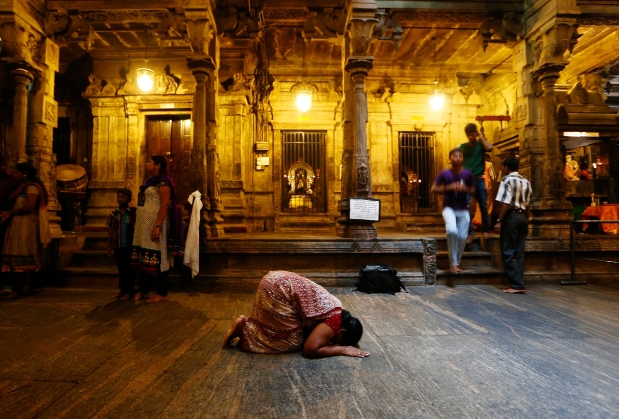Hinduism
What does Shraddha mean in Hinduism?
Published
5 years agoon
By
Vedic Tribe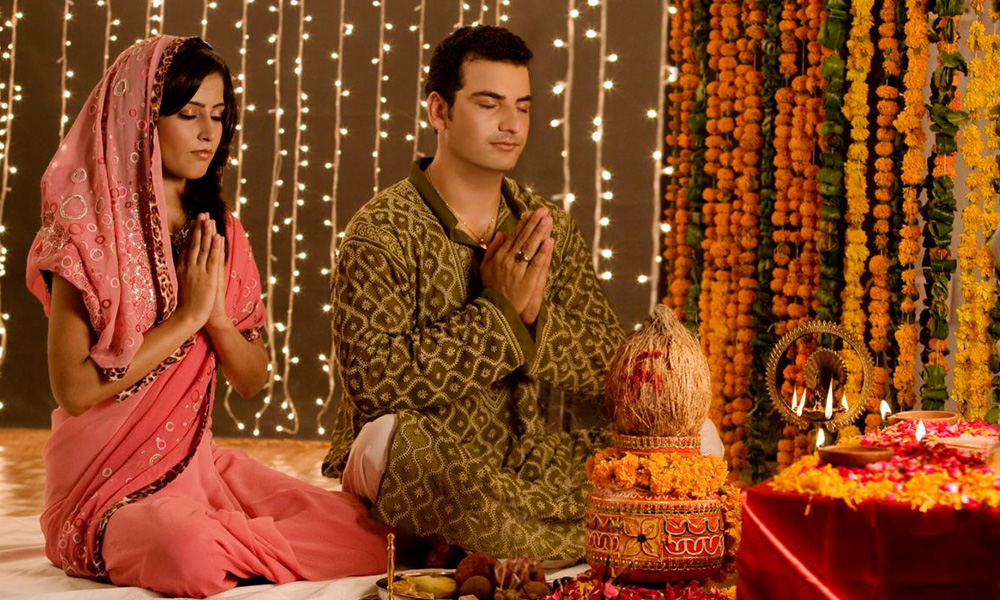
Shraddha is a Sanskrit word, referring to a concept similar to “faith,’””drive” or “purpose.” Although it does not have a direct English translation, it describes a type of positive energy that comes from deep within a person, shaping their world and life. The term is derived from two Sanskrit roots: shrat meaning “truth,” “heart” or “faithfulness,” and dha, meaning “to direct one’s mind toward.”
In Hinduism, shraddha is also a ceremony performed in honor of a deceased ancestor. It is considered to be the social and religious responsibility of all male Hindus and is one of the most important rites connected with ancestor worship. Offerings of food and drink are made to the deceased, alongside sacred rituals to nourish, protect and support their passage from lower to higher realms.
What do we need most in order to succeed in life—mundane and spiritual? Possibly, there are many answers that can be enlisted. But according to Swami Vivekananda, the most vital and essential quality needed to succeed in life is Shraddha.
What is Shraddha? What is its English translation? Says Swami Vivekananda, while narrating the story of Nachiketa in the Kathopanishad:
I would not translate this word Shraddha to you, it would be a mistake; it is a wonderful word to understand, and much depends on it; we will see how it works, for immediately we find Nachiketa telling himself, ‘I am superior to many, I am inferior to few, but nowhere am I the last, I can also do something.’ And this boldness increased, and the boy wanted to solve the problem which was in his mind, the problem of death. The solution could only be got by going to the house of Death, and the boy went. There he was, brave Nachiketa, waiting at the house of Death for three days, and you know how he obtained what he desired. What we want is this Shraddha.
Nachiketa had both—faith in himself and boldness. Hence Shraddha is faith plus boldness. Not only that. Shraddha has many shades of meaning and includes many ‘higher values’. It is considered a cardinal virtue in the Indian Tradition. Says one of the monks of the Ramakrishna Order:
Shraddha is a mental attitude constituted primarily of sincerity of purpose, humility, reverence and faith. You have Shraddha for your Guru—it is a sincere reverence. You have Shraddha for the Gita—it is admiration for those of its teachings you understand and faith in those that you do not. You give alms to a beggar with Shraddha—it is a sense of humility, combined with the hope that what you give will be acceptable and serviceable.
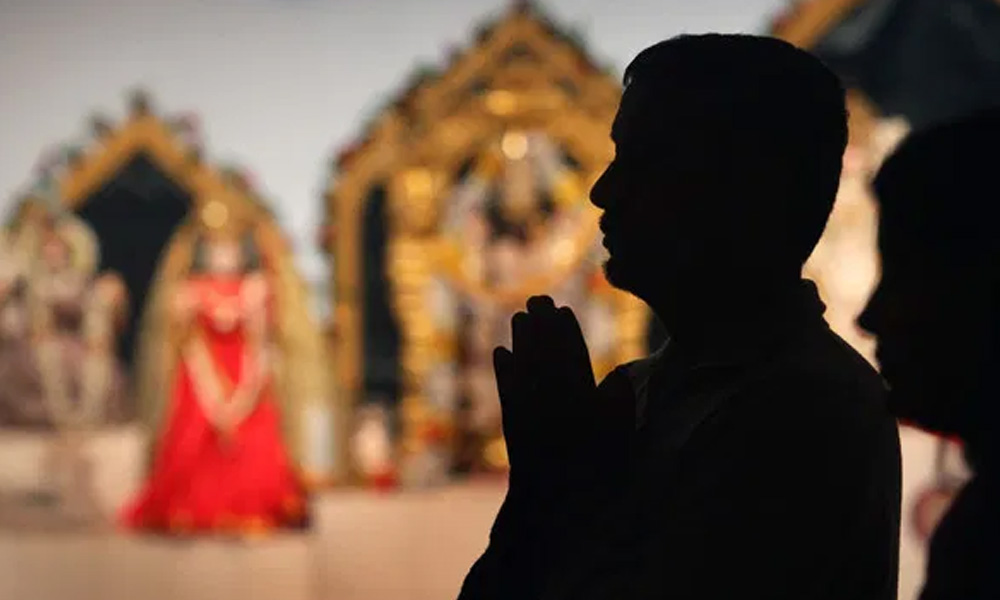
Purpose, humility, reverence and faith—all these together constitute Shraddha. So if one has Shraddha, one is endowed with all these qualities. And the Gita says, shraddhavan, one endowed with Shraddha, attains the highest knowledge (both mundane and spiritual). Let us contemplate on the four aspects of Shraddha stated above. All the four aspects, let us remember, are interrelated:
Purpose: Or prayojanam in Sanskrit, purpose means the force or the power of motivation with which one does something. According to the Gita [17.3] there are three types of forces that influence us in whatever we do or think. Called Gunas (sattva, rajas tamas), these forces are the basic building blocks of the universe. So, one’s purpose may be laced with either sattva or rajas or tamas Guna. One with a sattvik intent will be inclined towards pure and higher things in life. And those who are rajasik or tamasik, will have their Shraddha towards worldly things or wicked objectives. Purpose means the motive with which we seek, and here it means, seeking with faith and not doubt and suspicion.
Humility: It is the quality of receptivity and willingness to learn and to undergo all that is involved in learning. Humility is not an attitude of servility but it is the ability to let go one’s ego and bend oneself to receive something. Sri Ramakrishna used to say that rain water always flows downwards. Similarly knowledge and all higher things in life go towards a receiver who is opened with humility. You cannot pour milk into a cup already filled! Nor can knowledge be imparted to one who is filled with a sense of pride that he already knows everything.
Reverence: Shraddha and reverence always go together. One should have a sense of respect and adoration as opposed to casualness and carelessness. It is respect for something that endows one with continuity and stability. Sage Patanjali (1.14) includes respect (satkara) as one of the vital components for the practice of mind-controlling. Respect is called also Bhava, the emotional disposition. Swamiji says,
When in ancient times this knowledge (Jnana) and this feeling (Bhava) thus blossomed forth simultaneously in the heart of the Rishi, then the Highest Truth become poetic, and then the Vedas and other scriptures were composed.

At the core of respectfulness lies admiration and appreciation. We admire and admire, and that becomes frozen into a respectful attitude. Respect is also described as an attitude of non-exploitation—one is honest and devoted and does not behave with calculation.
Faith: Faith is the very basis of normal life. One cannot be normal if one doubts everything. Faith means being firmly rooted in the presence of something. In fact, the term Shraddha primarily conveys the idea of faith. Swami Vivekananda too mostly uses the term to mean faith. He says:
The . . . qualification required is Shraddha, faith. One must have tremendous faith in religion and God. . . . A great sage once told me that not one in twenty millions in this world believed in God. I asked him why, and he told me, ‘Suppose there is a thief in this room, and he gets to know that there is a mass of gold in the next room, and only a very thin partition between the two rooms; what will be the condition of that thief?’ I answered, ‘He will not be able to sleep at all; his brain will be actively thinking of some means of getting at the gold, and he will think of nothing else.’ Then he replied, ‘Do you believe that a man could believe in God and not go mad to get Him? If a man sincerely believes that there is that immense, infinite mine of Bliss, and that It can be reached, would not that man go mad in his struggle to reach It?’ Strong faith in God and the consequent eagerness to reach Him constitute Shraddha.
Purpose, humility, reverence and faith, thus, together are called Shraddha.
The Capacity ‘to Hold Truth’
In its etymological sense, Shraddha means our inherent capacity to hold the truth (shrat dharane). And indeed so. Here is some truth. How do you know it? By holding it to be true. That holding-ness is called Shraddha. It is an inherent power like we have the inherent power to digest food without which we cannot live.
Let us look at Shraddha further. Adi Shankara says in his Viveka-chudamani [25];
Shastrasya guru-vakyasya satyabuddhi-avadharanam;
Sa shraddha kathita shadbhir-yaya vastu-upalabhyate
Acceptance by firm judgement as true of what the scriptures and the guru instruct, is called by sages shraddha or faith, by means of which the Reality is perceived.
Says Swami Ranganathananda, the 13th President of the Ramakrishna Math and Mission:
Here we have a precise definition of the term shraddha. Understanding as true the words of guru and scriptures is shraddha or faith (shastrasya guru-vakyasya satyabuddhi-avadharanam). What we usually understand as faith is mere static belief (visvasa). Such a static believer simply swallows what others say. He does not subject it to evidential tests. But shraddha here means faith with a view to investigating the truth of what is told. Deep rational thinking forms the basis of such faith. Satya-buddhi-avadharanammeans ascertaining through reason the truth of what is taught. This makes us go ahead from the level of faith to the level of truth.
Whether it is physical science or science of spirituality, as sciences they tell us their respective truths. We must have faith that the teachers of these sciences are telling the truth, and when this faith makes us forge ahead to experience the truth, it is shraddha. It is not merely believing, but believing that the teachings of the scriptures and the words of guru are true, and struggling to reach that truth-level. Shraddha is that by which the truth is realized (sa shraddha kathita sadbhir-yaya vastu-palabhyate).

Sri Ramakrishna gives a beautiful illustration. When we go to fish in a lake, we take a fishing rod and line, with bait fixed to it. We cast the line and bait into the lake and wait patiently. We may not have seen fishes in that lake. We have only heard from others who have fished there. Our shraddha in their words makes us go to the lake and verify the truth of their statement. We sit for a long time and yet fail to catch a fish. But by this alone we do not conclude that there is no fish in the lake. We come again the next day and keep striving. What is the basis of this unremitting effort? It is the dynamic faith that there is fish in the lake. All great discoveries in the fields of science and religion are the result of such a positive attitude and the action based on such an attitude. Finally when we catch a fish, our belief turns into a verified truth. Similarly, there is a divine truth hidden in all of us. Our guru tells us about it and so do the scriptures. We have not seen it. But we believe in their words and struggle to make that belief true by realization. That’s why Thomas Huxley, a collaborator of Darwin, said in the last century (quoted by J. Arthur Thompson in his Introduction to Science, p. 22):
‘The longer I live, the more obvious it is to me that the most sacred act of a man’s life is to say and feel, “I believe such and such to be true.” All the greatest rewards and all the heaviest penalties of existence cling about that act.’
It is not enough to say, ‘I believe’. Any fool can say that. But a man who says, ‘I believe such and such to be true’ and carries his life to that truth-level has transformed his belief into truth. He possessesShraddha. It is a capacity to convert belief into truth and conviction. What does Shraddha mean in physical sciences? It means a faith in the meaningfulness of the universe. A scientist cannot investigate into the mysteries of nature unless he has a prior feeling that nature is worth investigating, that there is some meaning behind all the confusing mass of data before him. Without that prior faith, he cannot get even the impulse to undertake his scientific inquiry.
That is why in another place Shankara defines Shraddha as astikya buddhih, which, precisely translated, will mean ‘the positive-attitude-oriented reason’. There is tremendous dynamism in such an attitude, which transforms itself into truth and conviction through direct experience.
Shraddha is an important tool without which no success can be had in our inner and outer lives. Shraddha is the basis of all healthy and stable human relationships and dealings as well.
Shraddha: Swamiji’s Mission
The following two statements of Swami Vivekananda aptly illustrate how deeply Swamiji valued cultivation of Shraddha. He says,
To preach the doctrine of Shraddha or genuine faith is the mission of my life. Let me repeat to you that this faith is one of the potent factors of humanity and of all religions. First, have faith in yourselves. Know that though one may be a little bubble and another may be a mountain-high wave, yet behind both the bubble and the wave there is the infinite ocean.
What makes the difference between man and man is the difference in this Shraddha and nothing else. What makes one man great and another weak and low is this Shraddha. . . . this Shraddha is what I want, and what all of us here want, this faith in ourselves, and before you is the great task to get that faith. Give up the awful disease that is creeping into our national blood, that idea of ridiculing everything, that loss of seriousness. Give that up. Be strong and have this Shraddha, and everything else is bound to follow.
Conclusion
Indeed, Shraddha in oneself, Shraddha in God who has created us, and Shraddha in the divinity of man—this is what gives meaning to life. It is the power of Shraddha that makes everything possible. Swami Vivekananda said that the history of the world is the history of those people who had this Shraddha. It is power behind all powers, a power that empowers life and is the signal cause of all success, growth and strength. Let us invoke the power of Shraddha in our lives, as the Shraddha Suktam from the Rig Veda does:
We invite the Goddess Shraddha in the morning. We invite Goddess Shraddha at noon and at sunset. O Goddess Shraddha, bless us that we may have Shraddha in this life, at this time, and in this place.
References
1. CW, 3: 319
2. Swami Swarupananda, The Bhagavad Gita, Advaita Ashrama, Kolkata, p.80
3. CW, 5. 409-22
4. CW,1.407
5. The Message of Vivekachudamani by Swami Ranganathananda, Advaita Ashrma, Kolkata, pp.82-85
6. CW, 3:445
7. CW, 3.320
8. Rig Veda, 10-151, Shraddha Suktam, 5
~ As published in The Vedanta Kesary issue
You may like
-


Seven Vows and Steps (pheras) of Hindu Wedding explained
-


Atithi Devo Bhava meaning in Hinduism and India
-


Navaratri: The Nine Divine Nights of Maa Durga!
-


Significance of Bilva Leaf – Why is it dear to Lord shiva?
-


Concept of Time and Creation (‘Brahma Srishti’) in Padma Purana
-


Karma Yoga – Yog Through Selfless Actions
Hinduism
Significance of Bilva Leaf – Why is it dear to Lord shiva?
Published
5 years agoon
March 12, 2021By
Vedic Tribe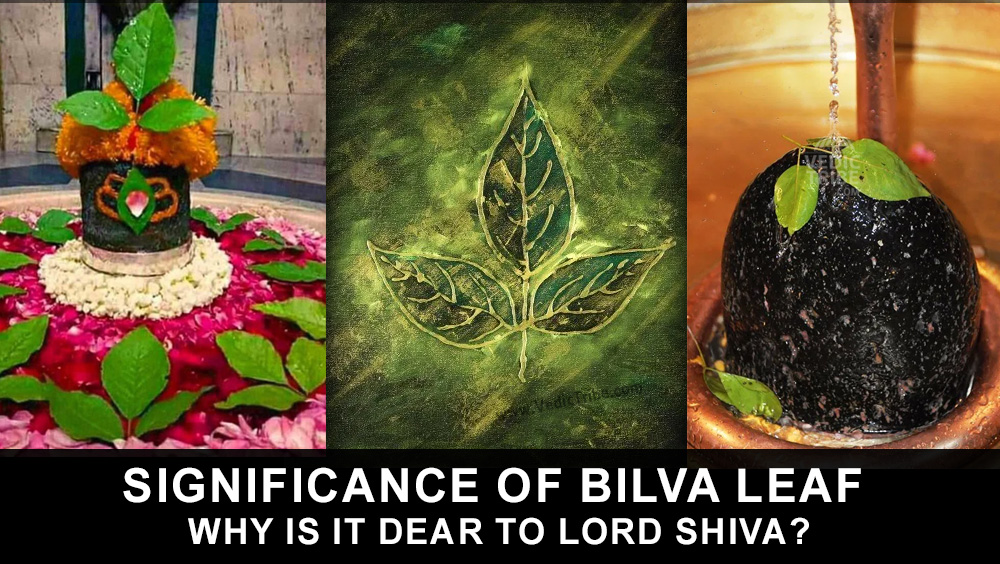
– Arun Gopinath
Hindus believe that the knowledge of medicinal plants is older than history itself, that it was gifted hundreds of thousands of years ago to the Vedic by Lord Brahma, the divine creator.
Thus when the Rishis of the Ayurveda sought to heal human suffering, they were able to draw on knowledge that had already been evolving for millennia in the forests of India. One tree about which they had a very deep knowledge was the Bilva tree. The science of Ayurveda values the Bilva highly for the medicinal properties contained in its root, fruit and leaves. According to Swami Sivananda, it is a healing tree which cures all diseases caused by vata (wind) and gives strength to the body.
More commonly known as the Bel Tree in India as well as other warm countries, this is a sacred tree having sacrificial importance and the first thing we can notice about the leaves is that they are generally trifoliate. This trifoliate leaf is symbolic of Trikaal or the Hindu Trinity of Devas known as Brahma Vishnu and Mahesh. The other names of this tree are Wood apple and its botanical name is Aegle marmilos.
The Bilva leaf or Patra as it is known, represents the Trinetra or three eyes of Lord Shiva, the main aspects like Trishakti (volition, action and knowledge), the three Shiva lingams and the three syllables of AUM or Omkar and are most favorite of Lord Shiva.
There are also five formed Bilva leaves known as PanchaDal patra found on some Bilva trees and these too are held as sacred for the worship of Lord Shiva. Bilva tree grows to a height of 8 meters with thorns. The leaves are alternate, ovate, trifoliate and aromatic. The tender leaves and shoots are consumed as salad greens. The flowers bloom in the month of May and will have a sweet fragrance.
It appears from all the Hindu texts and scriptures that the Bilva tree itself has been held very sacred and auspicious and is considered very holy since time immemorial thats its significance is mentioned in Mahapuranas in various forms of mantras. The Shiva Purana mentions a particular narration of how the usage of Bilva due to its scientific as well as medicinal properties is of great adavantage to Mankind.
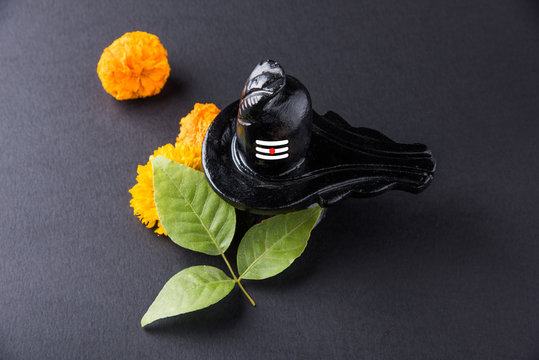
The 22nd Chapter of maha ShivaPurana narrates ” The trifoliate Bilva Patra is so sacred to Lord Shiva & is therefore a symbol of the Lord. Adored by all the Gods, its importance is difficult for anyone to comprehend. The sacred tree can only be known to a limited extent. Sacred sites of this Earth can only find their place at the root of this auspicious tree. Those who meditate upon Lord Mahadeva in His form of linga at the root of Bilva obtain Moksha & become purified souls by attaining Shiva. Such are the marvels of this sacred Bilva.”
The famous Shri Bilvashtakam (v. 6–7) Mentions :
Lakshmyaascha stana utpannam Mahaadeva sadaa priyam,
Bilva vriksham prayachchhaami eka bilvam Shivaarpanam.
Darshanam bilva vrikshasya sparshanam paapanaashanam,
Aghorapaapasamhaaram eka bilvam shivarpanam.
Translation :
Born from the heart of Goddess Lakshmi, the Bilva tree is ever dear to Mahadeva. So I ask this tree to offer one Bilva leaf to Lord Shiva. Even if (one) has darshan ( view) of the Bilva tree, and touches it, surely frees one from sin. The most terrible karma is destroyed when a Bilva leaf is offered to Lord Shiva.
It is also believed that Lakshmi, the Goddess of Wealth, also lives in the bel tree. Those who perform the puja of Shiva and Parvati devoutly, using the leaves, will be endowed with spiritual powers.
Scientific Advantages
According to Hindu scriptures, the Bilva is Triguna which is connected to the three Gunas or components of natural characteristics of the tree. In Hindu philosophy, the three Gunas are Sattva, Rajas & Tamas with Sattva being the pure most while Tamas normally is to do with darkness & ignorance.
The Sattvic component is believed to be more centered within the bilva patra and therefore the high capacity to absorb and emit Sattvic frequencies. This has various effects on the environment as well as on anyone merelt touching the leaf. One of them is the reduction of Rajasic-Tamasic atoms present in the atmosphere & more importantly within the human body.
A Sattvic leaf like bilva patra when brought in proximity of a person suffering from negative energies such as distress and anxiety is believed to medically reduce these energies within the human body. People with negative outlook towards life and their environment normally do not realize they have negative energies building up within their body and are at a risk of subconsciously harpering destructive thoughts also.
Whenever such people come into contact with a Sattvic atmosphere, what they fail to realize is their negative energies try to fight the positivity of a Sattva predominant environment. This struggle can build up at various levels and can vary from the human mind thinking negatively and can result sudden bursts of anger to destruction of things around them.
Medicinal uses
The roots, skin, fruits and the leaves of the Bilva tree are used for medicinal purpose. Bilva has astringent, edema lessening, anti-diarrhea, laxative and appetizer properties hence, can be used to cure both internal and external diseases.
The sacred tree has many medicinal usages and is advantageous in curing many human ailments such as :
- Bleeding gums.
- Bel fruit clears diarrhea, dysentry, phlegm, high blood pressure, morning sickness in pregnancy, stress.
- Asthma can be controlled when a mixture of dry bel leaf powder & honey is consumed daily
- Jaundice can be cured by consuming the extracted juice of the bilva leaves
- Anemia can be cured by drinking the powder of the bel fruit mixed with milk
- Bel fruit keeps the skin rejuvenated when pasted into a face pack; also cures joint aches
Hinduism
Concept of Time and Creation (‘Brahma Srishti’) in Padma Purana
Published
5 years agoon
March 12, 2021By
Vedic Tribe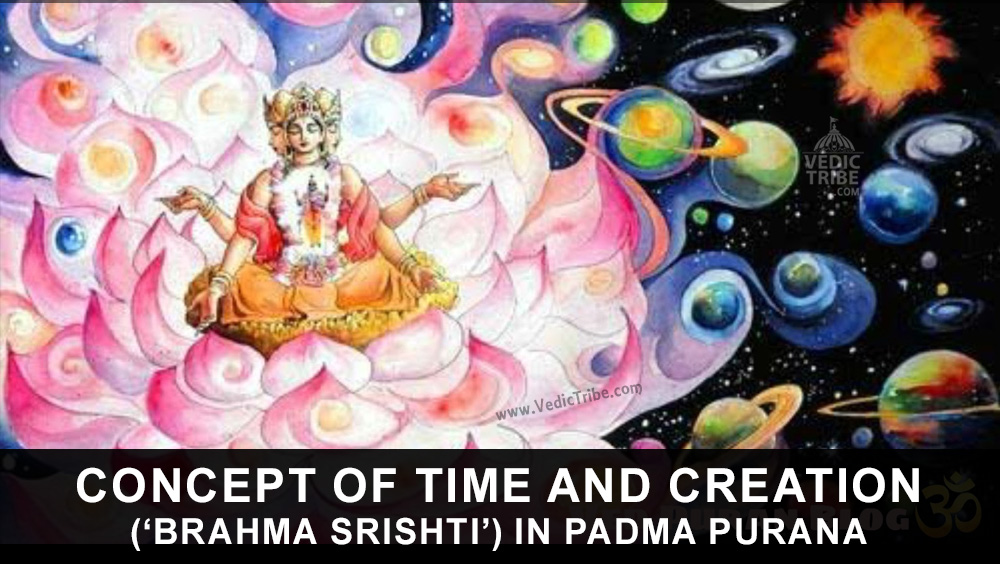
Pulastya Maha Muni affirmed to Bhishma that Brahma was Narayana Himself and that in reality he was Eternal. But in a formal sense it was stated that Brahma was ‘created’ and in that normally recognised manner Brahma had hundred years of age; apparently, the concept of Time would have to have a basis and that was why Brahma’s age was determined notionally as of hundred Brahma Years; in other words, ‘Para’or the first half was over and his present age has entered the ‘Paraartha’, the second half (viz. Fifty first year).This was how, the concept of Time emerged.
Every fifteen ‘Nimeshas’ constitute one ‘Kaashtha’; thirty Kashthas one one ‘Kala’; thirty Kalas make one ‘Muhurtha’; thirty Muhurtas make one day/night, thirty day/nights make on ‘Maasa’; (half Maasa makes one ‘Paksha’), six Maasas make one ‘Ayana’ and two Ayanas-Dakshinayana and Uttarayana- make one ‘Year’. Dakshinayana is a night for Devas and Uttarayana their day. One hundred human years make one day-night of Devas.
Twelve thousand Deva Years make four Yugas viz, Satya Yuga, Treta Yuja, Dwapara Yuga and Kali Yuga and these four Yugas make one Maha Yuga which is Brahma’s one day! Satya Yuga comprises 4800 DevaYears including ‘Sandhya mana’ of 400 years and ‘Sandhyamsha maana of additional 400 years; Treta Yuga comprises 3600 Deva Years including 600 years of ‘Sandhya/ Sandhyamsha mana’each; Dwapara Yuga of 2400 years including 200 years of ‘Sandhya/ Sandhyamsha mana’each and Kali Yuga of 1000 years including 100 years each of Sandhya / Sandhyamsha manas.Deva Years are 360 times more than human years. For instance, the duration of Kali Yuga in human year terms is 432,000 years; Dwapara’s is 864000; Treta Yuga’s is12, 96,000 and of Satya Yuga is 17, 28,000 years; all the Yugas totalling 432, 00, 00,000 (432 million) make one Chaturyuga and that constitutes one Brahma Day!
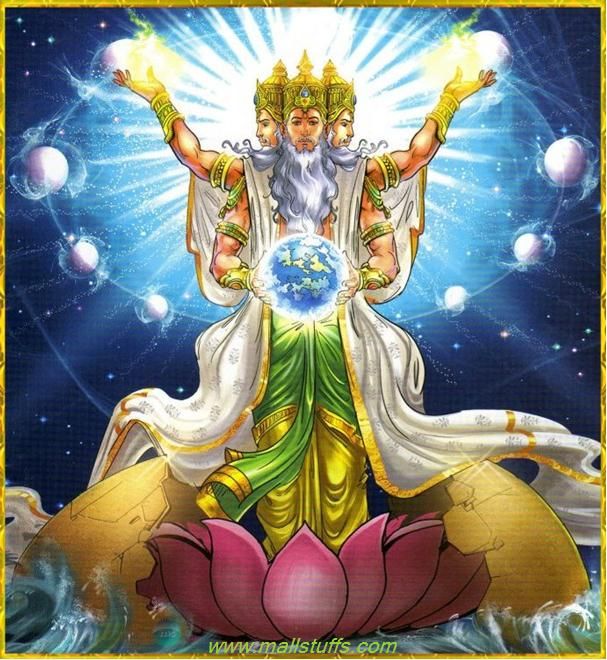
In one day of Brahma there are fourteen Manvantaras and each Manvantara has 8, 51,000 of Deva Years. There are two kalpas on one day-night of Brahma.At the end of the previous Kalpa, Brahma felt fresh from the previous night and found that Prithvi was submerged in water while Bhagavan Varaha Deva entered into water and Prithvi prayed to him; in response, Varahadeva emanated a ‘Ghur Ghur’ sound which was like the reverberation of Sama Veda, lifted up Prithvi from Rasala loka by the might of his horns, Devas rained fragrant flowers from the sky, Rishis went into rapturous tributes to Vishnu’s incarnated Varaha Rupa; and Brahma implored the latter to allow him recommence Srishti with his blessings as also to preserve and administer the Creation that he would so generate even as the Lord gracefully replied to say: ‘Tathastu!’ (So be it!).
Brahma’s first Srishti being Maha Tatva, the creation of Tanmatras was known as Bhuta Sarga or the Second Srishti; Vaikarika or Satvika Ahankara was the third Srishti of Indriyas or Aindriya Sarga; the Fourth Srishti is the Mukyha Sarga related to Mountains, Forests and other Sthaavara Srishti; the fifth Srishti relates to Pashu-Pakshi (Animals and Birds); the seventh Srishti was called Deva sarga or Urthva faced and was of Devas; and Seventh Srishti was of Manava Sarga; the Eighth was of Anugraha Sarga which could be of Satvika or Tamasic nature and finally the Ninth Srishti called the Kaumara Sarga which could be of Prakrita or Vaikrita Marg.
Depending on the carry forward of one’s own balance of ‘Papa-Punya’of the previous time-frame preceding the Pralaya, placement of lives was commenced by Brahma in the New Age. Arising out of his ‘Manasika Samkalpa’ (Mind born Proposal), Brahma created various species including Devas, Asuras, Pitaras and human beings. From his thighs, the evil Asuras emerged and as per his free will various birds were created.
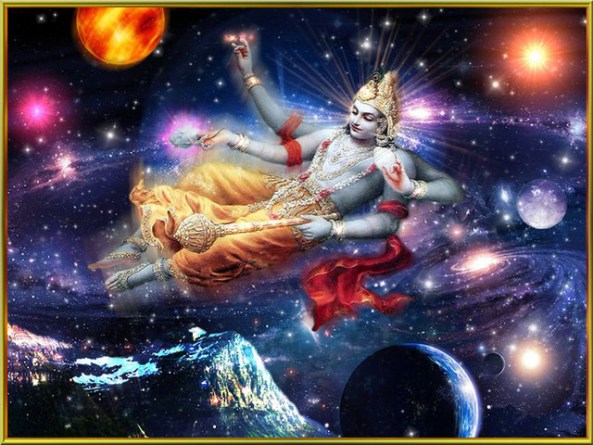
From his stomach surfaced cows, his shoulders the wolves; his face created horses, elephants, asses, nilgais, deer, camels, etc.each species multiplying several others. Brahma’s body hairs created fruits, roots and foodgrains. From his right extreme face, Brahma created, Gayatri Chhandah, Rig Veda, Tivritstoma, Rathantara, Agnihoshtha yagna; from South-faced he created Yajur Veda, Tristhub Chandas, Panchadasha stoma, Brihatsaama, etc; Sama Veda, Jagati Chhanda, Saptadashastoma, ‘Vairupa’ etc; from the Western face; Brahma created Ekavimshatstoma, Atharva Veda, Aptoryama, Anushthup chhanda, and Vairaja from the Uttaravarti Mukha. Miscellaneous ‘Pranis’ were created from any of the limbs of Brahma. To sum up thus at the beginning of the Kalpa, Prajapati Brahma created Devas, Asuras, Pitaras and human beings as also of Yakshas, Pishachas, Gandharvas, Apsaras, Siddhas, Kinnaras, Raakshasaas, Lions, Birds, Animals and Reptiles.
Focussing attention on human beings now, Bhishma asked the highlights of Varnashrama Vidhi and Pulastya Muni explained that Brahma created Brahmanas from the face, Kshatriyas from ‘Vakshasthali’ (chest), Vaishyas from thighs; and Shudras from the feet.These four Varnas are the important constituents of ‘Yagnas’; Devas are satisfied wirh their respective portions of ‘Havis’ (oblations) to Agni and being pleased with the Yagnas, Devas bestow good rains and good crops which leads to material prosperity.
The hearts and hands of every body tend to be clean and social customs and virtuous living would go hand in hand. Prajapati decided the duties of the Four Varnas, depending on the professions that human beings tended to follow like Brahmanas performing Yagnas, Vratas, Temple Tasks, and enabling various religious deeds of Virtue in favour of the members of three other Varnas etc.; Kshatriyas discharging the responsibilities of Kingship, Administration, Security against external enemies, collection of taxes and maintenance of Internal Law and Order; Vaishyas performing business, farming, trading and all matters involving finance, provision of materials to others by allowing reasonable profits for the services given etc. and Shudras supporting the members of the Three Varnas in the discharge of duties being undertaken by them.
Brahma materialised the above various kinds of Creations by applying his mental faculties but was not quite satisfied as the next generations so created were not adequate to fill in the universe; therefore he created Sages like Bhrigu, Pulaha, Kratu, Angira, Marichi, Daksha, Atri and Vasishtha, in addition to the four ‘Manasa Putras’ viz. Sanaka, Sanandana, Sanatana and Sanat Kumaras. As not all these sons were interested in family lives, Brahma created Rudra from his forehead and decided that half of the body be a woman; thus Eleven Rudras got materialised along with as many Rudranis who had a variety of Rupas ranging from ‘Sowmya’ (composure), ‘Krura’(unkindness), ‘Shanta’ (peacefulness), ‘Shyama’ (darkness), ‘Gaura’ (wheatish) and such other colours.
Further on, Brahma created Swayambhu Manu and the latter’s wife Shatarupa; the Manu couple gave birth to sons Priyavrata and Uttanapada and daughters Prasuti (married to Daksha) and Akruti (married to Ruchi Prajapati). To Prasuti and Daksha were born twenty four daughters, thirteen of whom were Shraddha, Lakshmi, Dhruti, Pushti, Tushti, Megha, Kriya, Buddhi, Lajja, Vapu, Shanti, Sidhi, and Kirthi (all these thirteen were married to Dharma); eleven more daughters were Khyati, Sati, Sambhuti, Smriti, Preeti, Kshama, Sannati, Anasuya, Urja, Swaha and Swadha; they were wedded respectively to Bhrigu, Shiva, Marichi, Angira, Pusasthya, Kratu, Atri, Vasishtha, Agni and Pitras.
The sons of Daksha’s daughters were Kamak by Shraddha, Darpa to Lakshmi, Niyam to Dhriti, Santhosh to Tushti, Lobha to Pushti, Shruta to Megha; Danda, Vinay and Naya to Kriya, Bodha to Buddhi, Vinay to Lajja, Vyavasayak to Vapu, Kshema to Shanti, Sukha to Siddhi, and Yash to Kirti.These were all the sons of Dharma. Kaam and Nandi gave birth to Harsha, the grand son of Dharma. Bhrigu and Khyati gave birth to Devi Lakshmi who was Lord Narayana’s wife. Bhagavan Rudra accepted Sati as his wife (Daksha’s daughter) but Devi Sati sacrificed her life pursuant to Daksha’s Yagna to which Rudra was uninvited but Sati insisted in attending it; she felt highly insulted by her father Daksha who also offended Rudra Deva and Rudra eventually destroyed Daksha Yagna. — with Srilan Srisukumaran.
Hinduism
Karma Yoga – Yog Through Selfless Actions
Published
5 years agoon
February 23, 2021By
Vedic Tribe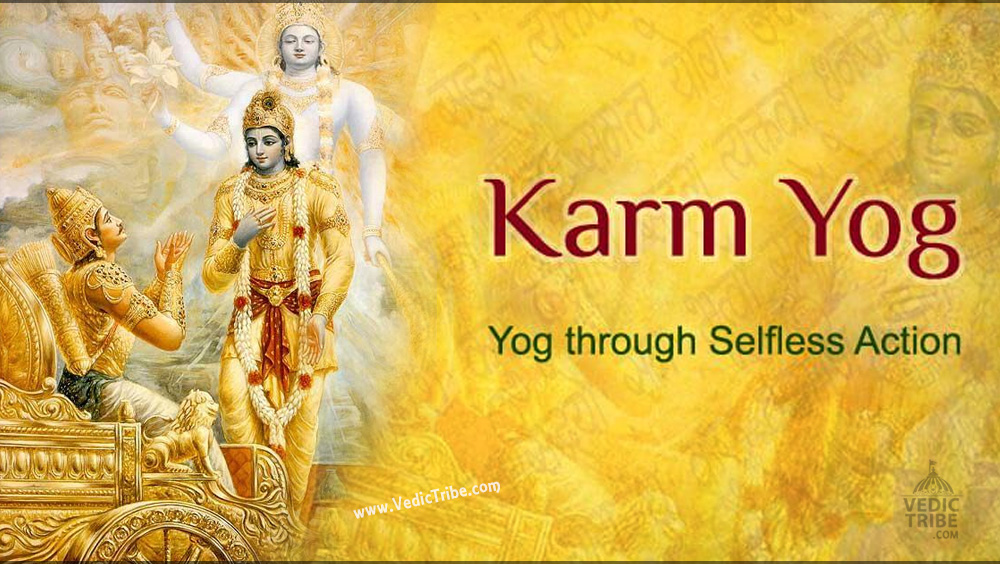
Karma Yoga is Meditation in Action:
“Karma” means action and “yoga” means loving unity of our mind with God. To perform karma and also practice yoga means to remain engaged in activity in the world while remaining in a state of devotional unity with God. This is true spiritual action.
Your bhakti yoga meditation practice will combine all these aspects and it will include:
- Daily sitting meditation
- Daily dynamic meditation woven seamlessly into the fabric of your life’s activities
Before we look at guidelines for these, let’s explore how process is described in the Hindu scriptures.
Karma Yoga of the Bhagavad Gita:
One of the most important scriptures of Hinduism, the Bhagavad Gita, was revealed under unusual circumstances: moments before a war and in the middle of a battlefield. It is comprised of a 700-verse dialogue between Lord Krishna, supreme God, and Arjuna, his loving disciple.
The all-in-one solution of the Bhagavad Gita for eliminating karma is Lord Krishna’s advice to practice akarma or actions that have no karmic consequence.
If we could perfect akarma in daily activity, the consequences of our actions would automatically be neutralized — even though we are engaged in action.
This means that from the point of view of karmic debt, no consequences would be added to our “account”. The only key to this is we must maintain an unbroken and continuous devotion to God.

Karma yoga philosophy in the Bhagavad Gita is summed up in one statement of Lord Krishna:
“Remember Me and fight.”
But is it really possible to simultaneously do devotional remembrance and be engaged in activity? Can the mind function in two places at the same time? This is definitely impossible, but for karma yoga to be done properly, both have to happen simultaneously.
For example, if you are at work and absorbed in a project, and remember God occasionally, how are both these actions accounted for as karmas?
The time you spent in devotional remembrance will be considered devotional action, and the time you spent engrossed in working will be considered normal action. This is not karma yoga.
Plus, a common misconception describes karma yoga as “performing action without being attached to the results”. Although this sounds noble, is it psychologically possible for any human being to do this?
The fact is because we are constantly trying to find authentic happiness, we will always anticipate the outcome of our actions in advance of doing them.
The practical form of the Gita’s karma yoga…
In the Gita, Krishna was both supreme God and Arjuna’s spiritual guide. Krishna advised Arjuna to surrender to Him and to simply follow His instructions. By transferring his motivation for action to a divine personality, Arjuna would not be responsible for the outcome of the actions he was instructed to perform.
For example, a police officer is issued a revolver, which he is instructed to use in the line of duty by his superiors. It could happen that he kills someone in the pursuit of law and order. In the eyes of the justice system, this will not be considered a crime. He did not use his own mental motivation to decide to kill someone — he simply followed the guidelines given to him by his superiors.
In Arjuna’s situation, in spite of engaging in war, all his actions were counted as devotion, because his heart, mind and body were fully dedicated to the will of Krishna.
This again highlights one of the most important points of karma yoga: The mind is the performer of action, not the physical body.
It is our personal motive that has to be carefully redirected for karmic consequences to change or be neutralized.

A Closer Look at the Spiritual Theory
If a practitioner is surrendered to a true divine Guru, and performs actions entrusted to him by his Guru, that activity is considered not only karma yoga, but also bhakti or spiritual action. It will be free of a karmic consequence. That practitioner is not directly attached to the results of that activity because his motive is to follow the instructions of his Guru.
Arjuna accepted Lord Krishn as his Guru at the very beginning of the Gita when he declared he was Lord Krishna’s disciple. He preserved the understanding during the entire Mahabharata War that he was doing service for his Guru.
In this way, just by holding this intention, his devotion remained unbroken and his actions were considered karma yoga. Thus, service to a true Guru is called karma yoga or devotion.
Practically speaking, a Guru will give instructions on how a practitioner can keep his mind engrossed in a state of continuous devotional remembrance. Simply by following these instructions, a disciple is automatically practicing karma yoga.
Those devotional guidelines take the form of (1) karma sanyas and (2) karma yoga.
Karma Sanyas – Quiet Time for Meditation
And old method of dyeing fabric in India was to place a cloth in a dye bath and then allow it to dry in the sun.
After drying, the intensity of the color faded. Again the cloth was placed in a dye bath, again it was placed in the sun, and again the color faded, but the second time more of the color remained.
After entering the dye bath multiple times, the color eventually became intense and fixed.
Similarly, to establish devotion in our hearts and minds, it is important to have a structured daily practice of sitting meditation.
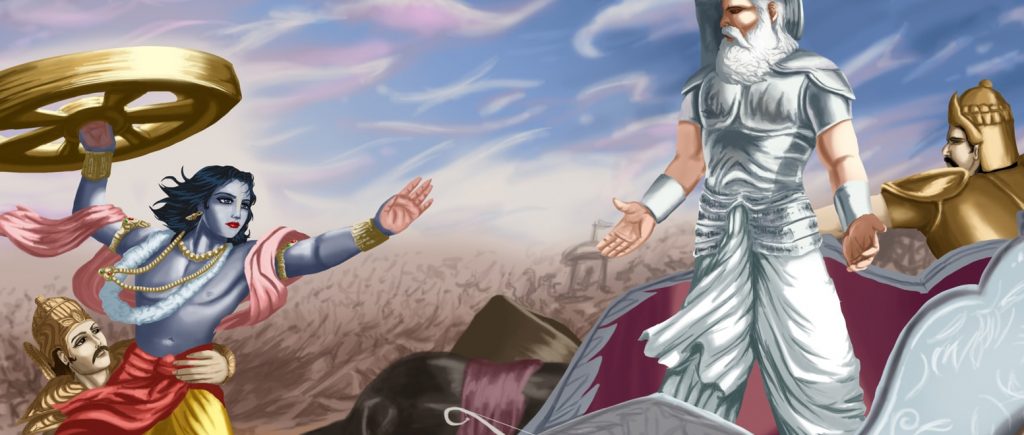
The main elements of a daily devotional practice include:
- Heart-centered prayer
- Kirtan or chanting meditation combined with active visualization
- Aarti-the offering of light – a brief ceremony that reaffirms the spirit of our devotional dedication
Karma Yoga – Dynamic Devotion
For the attainment of divine love, the Vedas state that there is only one rule and one prohibition that apply to bhakti yoga meditation. The rule is: “Always remember Radha Krishna.” The prohibition is, “Never forget Radha Krishna.”
This means that after our sitting meditation, our meditation should continue — while eating, sleeping, walking, working, talking, resting, and so on.
Wherever you are, all the time, whatever you are doing, remember your divine beloved and don’t forget Him! This simultaneous devotion and action is karma yoga. This state of devotional consciousness is cultivated over time with practice.
For example, in the old days street musicians with hand organs kept small monkeys. A monkey by nature is extremely active. How to make a monkey’s nature conform to sitting still, and that, too, in a confined space?

The musician’s technique was to first restrain the monkey with a 100-foot rope. If the monkey tried to go outside of this range, he was stopped. He thought, “Okay, I’ll jump around in a 100-foot area.”
When he was tied with a 50-foot rope he thought, “I went 100 feet yesterday, today I’m restricted to this much.” So he jumped around in a 50-foot area.
When the monkey was finally limited to only 1 foot of rope, he sat quietly, “Why should I drive myself crazy? I’ll just sit here.”
The human mind has this same monkey-like nature. It roams far and wide. Our goal is not to tame it’s active nature, but to train it to roam in a particular area. This is done by gently tying it with the devotional rope of love.
In sitting meditation we cultivate a feeling a devotional relationship with God. In active meditation we can continue this in three ways:
- Embed your intention — Every person has a mission that guides his life’s activities. For example, very few people like to work, but they do it because their mission is to support themselves or their family. While they are at work, although this motive is hidden deep in their mind, it still guides their decisions and actions.Similarly, when we firmly understand the purpose of our life is God-realization, this intention deeply embeds itself in the mind. If cultivated properly, this subconscious devotional intention remains in all our activities, even when we are sleeping.
- Feel divine presence — in sitting meditation we visualize and feel our relationship to God’s personal form. In activity, take hourly breaks for 30 seconds or a minute and with open eyes sense the presence of your worshipped form of God or Radha Krishna. Simply feel you are not alone. Imagine them near or far, sitting, standing or in any position, in any mood of love.
- Share your awareness — After visualizing God’s presence, either feel He is watching you or that you are showing Him what you are doing.
- Avoid wrong association — your associations and environment will affect your feeling of divine connection. Be mindful and avoid those situations that divert your devotional intention.
There is no restriction of time, place and activity for this remembrance. It can be done anywhere, at any time. You do not need to sit in a particular position or have closed eyes. This very simple practice will recall the blissful feelings of your seated meditation and help to stabilize your devotional experience.
Follow us on Facebook
Follow us on Twitter
Latest


Seven Vows and Steps (pheras) of Hindu Wedding explained
Views: 9,127 Indian marriages are well renowned around the world for all the rituals and events forming part of the...


Sari or Saree is symbol of Indian feminism and culture
Views: 7,364 One of the most sensual attires of a woman in India is undoubtedly the sari. It is a...


Atithi Devo Bhava meaning in Hinduism and India
Views: 7,129 Atithi Devo Bhava, an ancient line taken from the Hindu scriptures and was originally coined to depict a visiting person whose...


Sanskrit Is More Than Just A Method To Communicate
Views: 5,367 -By Ojaswita Krishnaa Chaturvedi anskrit is the language of ancient India, the earliest compilation of sound, syllables and...


Significance of Baisakhi / Vaisakhi
Views: 6,578 Baiskhi is also spelled ‘Vaisakhi’, and is a vibrant Festival considered to be an extremely important festival in...


Navaratri: The Nine Divine Nights of Maa Durga!
Views: 7,686 – Shri Gyan Rajhans Navratri or the nine holy days are auspicious days of the lunar calendar according...


History of Vastu Shastra
Views: 10,871 Vastu Shastra (or short just Vastu) is the Indian science of space and architecture and how we may...


Significance of Bilva Leaf – Why is it dear to Lord shiva?
Views: 10,521 – Arun Gopinath Hindus believe that the knowledge of medicinal plants is older than history itself, that it...


Concept of Time and Creation (‘Brahma Srishti’) in Padma Purana
Views: 10,782 Pulastya Maha Muni affirmed to Bhishma that Brahma was Narayana Himself and that in reality he was Eternal....


Karma Yoga – Yog Through Selfless Actions
Views: 9,676 Karma Yoga is Meditation in Action: “Karma” means action and “yoga” means loving unity of our mind with...

